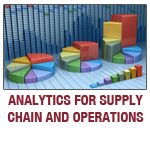Pop Quiz
Which analyst’s statement is correct?
Analyst Joe says, “I built a simulation model to optimize my supply chain.”
Analyst Jane says, “My optimization model simulates the behavior of my supply chain.”
Background
Before we answer the quiz we need to answer a few other questions starting with:
What are optimization and simulation?
Optimization is the process of identifying “what’s best” from a set of possible solutions while adhering to the business limits of a supply chain. For instance, there are several ways to move products from Chicago to LA, but not all options are equal. If your goal is to lower transportation costs, then “what’s best” might be using commercial trucks or trains. If your aim is to reduce transportation time, then air freight could be the best choice.
For example, in Inventory Positioning, optimization helps determine the “right” inventory levels across a supply network when demand and/or lead time are uncertain. Here, the optimization model seeks to balance the competing goals of lowering inventory holding costs and keeping a high service level (fill rate).
Some examples of optimization used in supply chain management are:
- Risk management – identify the best strategy to minimize potential disruption
- Inventory positioning – identify the best inventory position
- Network design – identify the best network to serve your customers
- Sourcing decisions – minimize the total costs of making products at manufacturing plants and shipping to end customers to meet all demand.
Simulation is the action of walking/stepping through the details of a process in a controlled, often virtual, environment based on specific rules in order replicate the way a system works, usually with the goal of gaining a better understanding of the system. In short, simulation is the process of replicating “what is.” After“what is” is well understood the next logical step is to ask “what if.” Thus, the true value of a simulation model is in providing a virtual sandbox for doing what-if analyses, which help decision makers identify the impact of different variables on an organization’s supply chain. Almost always, the simulation model will generate data about the system that can be post-processed into meaningful metrics for high-level business analysis.
For instance, simulation can be used to model customers lining up to check out of a grocery store. In this example, the analyst could test scenarios such as the effect of doubling the number of open check-out stations on the average wait time of customers during peak busy hours. Another example of a model is one that simulates an assembly line process. This assembly line model can then be used to identify bottlenecks as well as test the effect of improving production time at specific stations in the assembly line (improvements that could require capital investment in real life) on the overall throughput of the assembly line.
Some examples of simulation used in supply chain management are:
- Manufacuturing processes – model the production processes including setup costs to find bottlenecks and analyze improvement ideas
- Distribution decisions – model the transportation flow under different demand constraints to see how it performs
- Warehouse flow – model the pick and pack process using the real layout to determine how to effectively manage the flow
How do you know when to optimize and and when to simulate?
Optimization is typically used when the goal is to find “what’s best” given a set of specific business objectives and constraints. It is absolutely necessary that the decisions to be made are all quantifiable. More precisely, the decision to be made is a set of variables whose values are to be determined, the objectives are a set of mathematical functions that are optimized (maximized or minimized), and the constraints are the boundary conditions on the decision variables.
Simulation is typically used when the goal is to understand “what is” so that “what if” questions can be addressed, such as identifying the behavior of a supply chain when a set of business constraints change. Simulation models often serve to visualize the behavior of a system/process as well as to systematically generate values based on specific rules. The whole point is to generate sample values or collect measurements that help understand “what is” which is seldom equivalent to “what’s best.”
When is optimization confused with simulation?
Most people often confuse the process of doing sensitivity analysis of an optimization model as simulation. Sensitivity analysis and what-if analysis (scenario generation) with an optimization model is technically not the same as simulation. A simulation model is fundamentally meant to replicate a system—“what is”—while sensitivity analysis of an optimization model does not (in fact, almost never) replicate(s) the current system.
When is simulation confused with optimization?
When an analyst performs what-if analysis by varying the parameters of a simulation model it is possible to identify the parameter set that yields the “best” scenario. This, however, does not make the simulation model an optimization model; rather, the analyst is only using the simulation model as a fancy calculator to find the best solution out of a few feasible solutions instead of the best solution out of all feasible solutions.
Conclusion
Let’s go back now to the pop quiz, the answer we give is that both analysts’ statements are wrong! Joe’s simulation model will help him find the best solution(s) from a set of scenarios he plans to run and Jane’s optimization model can only simulate the behavior of a fully optimized supply chain.
Whether to use optimization or simulation will be determined by the goal of the analysis. Optimization should be used when the goal is to determine “what’s best” and simulation should be used when the goal is to understand “what is” so that “what if” questions can be addressed. However, this does not preclude the use of both optimization and simulation in a supply chain project. In fact, OPS Rules has used simulation models to validate the best solutions from optimization models in many previous end-to-end supply chain optimization projects. Similarly, a simulation model can be used to generate some missing data for use in an optimization model. In previous engagements, OPS Rules has utilized both simulation and optimization techniques to generate tremendous value to clients.
Written by Desmond Torkornoo and Billy Hou

